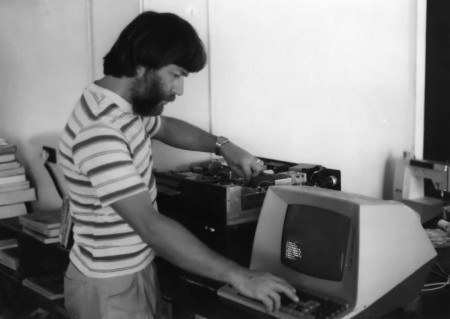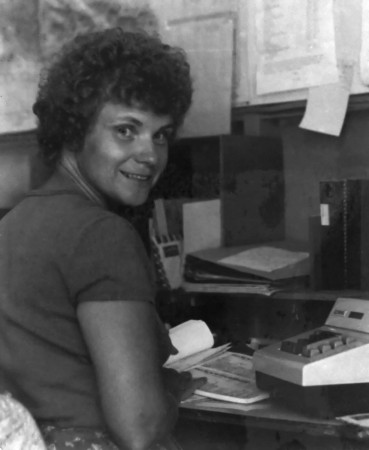by Jan Messersmith from the March 2000 issue of The Storyboard.
It’s hard to imagine how we ever got along without computers. When Eunice and I first came to Madang in 1981, our office equipment consisted of a rusty manual typewriter and a fairly accurate mechanical adding machine. The office fax machine hadn’t been invented yet, and a copy machine . . . forget it! We brought with us one of the first small computers available. It was called an IMSAI (we nicknamed it Murphy). It had two giant eight inch floppy disk drives, a big green screen, and a hundred pound printer that used cute little things called daisy wheels with the letters on the ends of the petals. Murphy soon succumbed to the moist salt air and we were left computerless.

By 1983 our group had decided to purchase a minicomputer. The minis were mankind’s first feeble attempt to manufacture computers that regular people could use. For the techno-weenies out there, it was a DEC PDP-11/73. I can clearly remember praying while looking at the four foot high stack of manuals that came with it. I had never even seen one of those machines before. We did get it all working, and it proved very useful, however difficult it was to learn to use. It was fairly easy to network it, so by the mid-eighties we had five “dumb” terminals connected to it. We ran a great deal of linguistic material through it, all of our administrative paperwork, our newsletters and our accounting system. It was, however, very expensive equipment to purchase and also expensive to maintain.
Because so much of our critical work is done in remote locations, we needed to get information recorded in a way that a computer could understand. Enter the Radio Shack Model 100! This little machine was proof that if there are enough people with a job that needs to be done, somebody will invent a machine to do it. It was a kind of stone age laptop. The translators used the Model 100s to enter village stories and translated scripture, and to perform simple computing tasks such as writing letters, storing addresses, and yes, playing games. They could record information on audio cassette recorders and send it to town where we could read it (with prayer and holding your mouth just right) and transfer it to the DEC for heavy duty processing. We were thankful during this period for what we could do with these machines, but at the same time exasperated by the knowledge that others were doing much more with different equipment. By this time the PC had been invented by IBM and instantly copied by others. We were held back by our reluctance to let go of our investment in machinery and the knowledge of how to use it.
The single most important factor in our decision to change to PCs was the invention of desktop publishing. This technology was impossible to resist. When Eunice and I returned from furlough in 1988, we brought back with us a personal computer, a Hewlett Packard ScanJet scanner, and a Hewlett Packard LaserJet II printer. (Both of the HP machines still work today.) As we learned to use these machines, we began to depend more and more on them to work efficiently. We wrote an accounting program in BASIC, which we used until 1998. We also produced many other programs to help in office management. The Summer Institute of Linguistics (Wycliffe Bible Translators) was producing a great deal of software for the linguistics and translation area, all of which they made available to us. During the period of 1988 to 1990 our operation was completely transformed in every area of effort by the presence of personal computers.
Today, we have nine PCs in our office alone. They are networked together so that we can easily share information and printers. We just purchased a Konica network printer. It’s like a big heavy duty copy machine that shows up on your computer just like a printer. We used it to produce this issue of The Storyboard. Our translation teams all have at least one computer and some have as many as three. We transfer information by email attachments if we’re ‘connected’ and by floppy diskette if we’re not.

It’s hard to say what may be in the future. At this point we’re waiting for satellite phone technology to become affordable to us. Truly rugged and dependable laptop computers still seem to be unavailable. Wonderful new gadgets lay just over the horizon. We’ll have difficulty deciding that we need them and can afford them. Then after a year, we’ll wonder how we ever got along without them.
[ Editor’s note: I can scarcely believe how much things have changed in ten years. We now have fifteen PCs in our office plus a menagerie of notebook computers which come and go. We have a satellite dish (VSAT) on the roof which gives us excellent speed when connected to the Internet. Most of us do our banking on line. Skype made long distance calls a thing of the past. There are three wireless access points in our office buildings. A wireless link across Binnen Harbour brings the Internet to my house. We print and scan on two large network multi-function printers. We can even produce books of up to eighty pages on these printers, in full color! What will the next ten years bring? ]